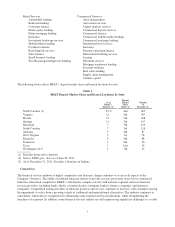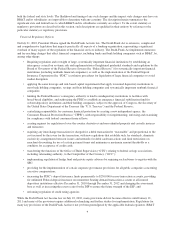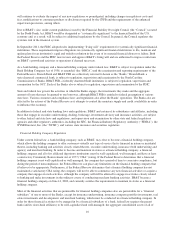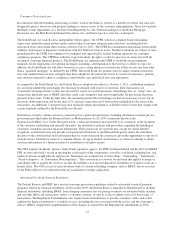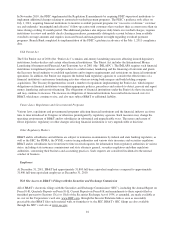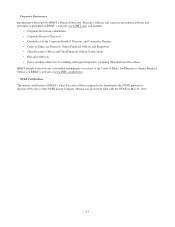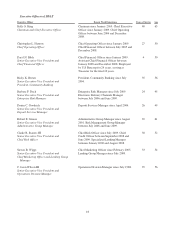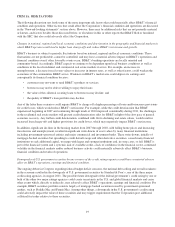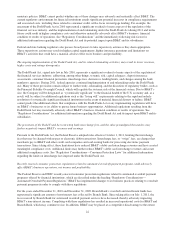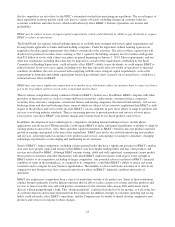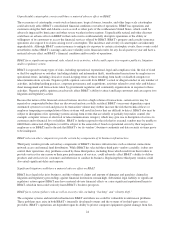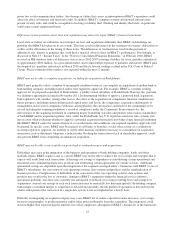BB&T 2011 Annual Report Download - page 16
Download and view the complete annual report
Please find page 16 of the 2011 BB&T annual report below. You can navigate through the pages in the report by either clicking on the pages listed below, or by using the keyword search tool below to find specific information within the annual report.
In November 2010, the FDIC supplemented the Regulation E amendments by requiring FDIC-supervised institutions to
implement additional changes relating to automated overdraft payment programs. The FDIC’s guidance took effect on
July 1, 2011, requiring financial institutions to monitor overdraft payment programs for “excessive or chronic” customer
use and undertake “meaningful and effective” follow-up action with customers that overdraw their accounts more than six
times during a rolling 12-month period. The additional guidance also imposes daily limits on overdraft charges, requires
institutions to review and modify check-clearing procedures, prominently distinguish account balances from available
overdraft coverage amounts and requires increased board and management oversight regarding overdraft payment
programs. Branch Bank completed its implementation of the FDIC’s guidance in advance of the July 1, 2011 compliance
date.
USA Patriot Act
The USA Patriot Act of 2001 (the “Patriot Act”) contains anti-money laundering measures affecting insured depository
institutions, broker-dealers and certain other financial institutions. The Patriot Act includes the International Money
Laundering Abatement and Financial Anti-Terrorism Act of 2001 (the “IMLAFA”). The IMLAFA requires such financial
institutions to implement policies and procedures to combat money laundering and the financing of terrorism and grants
the Secretary broad authority to establish regulations and to impose requirements and restrictions on financial institutions’
operations. In addition, the Patriot Act requires the federal bank regulatory agencies to consider the effectiveness of a
financial institution’s anti-money laundering activities when reviewing bank mergers and bank holding company
acquisitions. The Treasury Department has issued a number of regulations implementing the Patriot Act, which impose
obligations on financial institutions to maintain appropriate policies, procedures and controls to detect, prevent and report
money laundering and terrorist financing. The obligations of financial institutions under the Patriot Act have increased,
and may continue to increase. The increase in obligations of financial institutions has resulted in increased costs for
BB&T, which may continue to rise, and also may subject BB&T to additional liability.
Future Laws, Regulations and Governmental Programs
Various laws, regulations and governmental programs affecting financial institutions and the financial industry are from
time to time introduced in Congress or otherwise promulgated by regulatory agencies. Such measures may change the
operating environment of BB&T and its subsidiaries in substantial and unpredictable ways. The nature and extent of
future legislative, regulatory or other changes affecting financial institutions is very unpredictable at this time.
Other Regulatory Matters
BB&T and its subsidiaries and affiliates are subject to numerous examinations by federal and state banking regulators, as
well as the SEC, the FINRA, the NYSE, various taxing authorities and various state insurance and securities regulators.
BB&T and its subsidiaries have from time to time received requests for information from regulatory authorities in various
states, including state insurance commissions and state attorneys general, securities regulators and other regulatory
authorities, concerning their business and accounting practices. Such requests are considered incidental to the normal
conduct of business.
Employees
At December 31, 2011, BB&T had approximately 31,800 full-time equivalent employees compared to approximately
31,400 full-time equivalent employees at December 31, 2010.
Web Site Access to BB&T’s Filings with the Securities and Exchange Commission
All of BB&T’s electronic filings with the Securities and Exchange Commission (“SEC”), including the Annual Report on
Form 10-K, Quarterly Reports on Form 10-Q, Current Reports on Form 8-K and amendments to these reports filed or
furnished pursuant to Sections 13(a) or 15(d) of the Securities Exchange Act of 1934, as amended, are made available at
no cost on the Corporation’s web site, www.BBT.com, through the Investor Relations link as soon as reasonably
practicable after BB&T files such material with, or furnishes it to, the SEC. BB&T’s SEC filings are also available
through the SEC’s web site at www.sec.gov.
16



